maintenance CITROEN C-ELYSÉE 2014 Handbook (in English)
[x] Cancel search | Manufacturer: CITROEN, Model Year: 2014, Model line: C-ELYSÉE, Model: CITROEN C-ELYSÉE 2014Pages: 257, PDF Size: 9.06 MB
Page 5 of 257
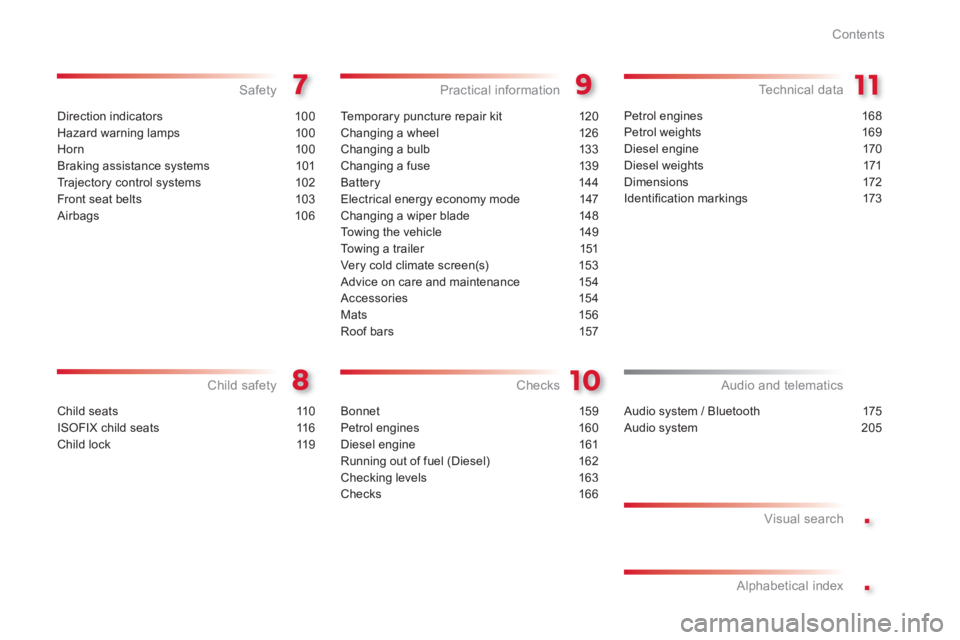
.
.
Contents
Direction indicators 100
Hazard warning lamps 100
Horn 100
Braking assistance systems 101
Tr ajectory control systems 102
Front seat belts 103
Airbags 106
Safety
Child seats 110
ISOFIX child seats 116
Child lock 119
Child safety
Te m p o r a ry puncture repair kit 120
Changing a wheel 126
Changing a bulb 133
Changing a fuse 139
Battery 144
Electrical energy economy mode 147
Changing a wiper blade 148
To w i ng the vehicle 149
To w i ng a trailer 151
Very cold climate screen(s) 153
Advice on care and maintenance 154
Accessories 154
Mats 156
Roof bars 157
Practical information
Petrol engines 168
Petrol weights 169
Diesel engine 170
Diesel weights 171
Dimensions 172
Identifi cation markings 173
Technical data
Audio system / Bluetooth 175
Audio system 205
Audio and telematics
Visual search
Alphabetical index Checks
Bonnet 159
Petrol engines 160
Diesel engine 161
Running out of fuel (Diesel) 162
Checking levels 163
Checks 166
Page 23 of 257
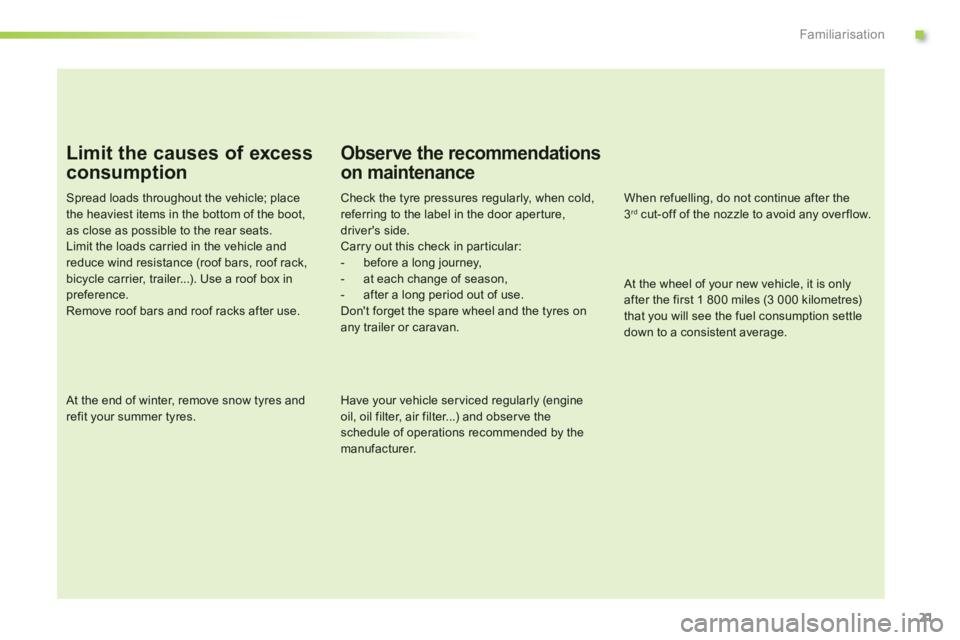
.
21
Familiarisation
Limit the causes of excess
consumption
Spread loads throughout the vehicle; placethe heaviest items in the bottom of the boot,as close as possible to the rear seats.Limit the loads carried in the vehicle and reduce wind resistance (roof bars, roof rack, bicycle carrier, trailer...). Use a roof box inpreference.Remove roof bars and roof racks after use.
At the end of winter, remove snow tyres and refit your summer tyres.
Observe the recommendations
on maintenance
Check the tyre pressures regularly, when cold, referring to the label in the door aper ture, driver's side.Carry out this check in par ticular:- before a long journey,- at each change of season,- after a long period out of use. Don't forget the spare wheel and the tyres onany trailer or caravan.
Have your vehicle ser viced regularly (engine oil, oil filter, air filter...) and obser ve the
schedule of operations recommended by themanufacturer.
When refuelling, do not continue after the3 rd
cut-off of the nozzle to avoid any over flow.
At the wheel of your new vehicle, it is only after the first 1 800 miles (3 000 kilometres) that you will see the fuel consumption settledown to a consistent average.
Page 64 of 257
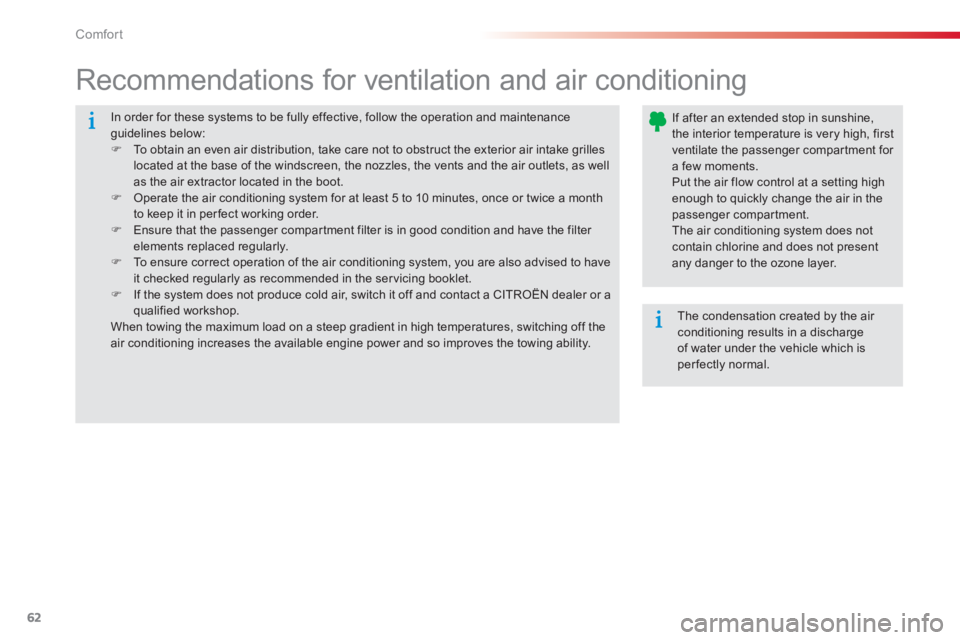
62
Comfort
In order for these systems to be fully effective, follow the operation and maintenance guidelines below: �)To obtain an even air distribution, take care not to obstruct the exterior air intake grilles
located at the base of the windscreen, the nozzles, the vents and the air outlets, as wellas the air extractor located in the boot. �)Operate the air conditioning system for at least 5 to 10 minutes, once or twice a month to keep it in perfect working order. �)Ensure that the passenger compar tment filter is in good condition and have the filter elements replaced regularly. �)To ensure correct operation of the air conditioning system, you are also advised to have it checked regularly as recommended in the ser vicing booklet.�)If the system does not produce cold air, switch it off and contact a CITROËN dealer or a qualified workshop.
When towing the maximum load on a steep gradient in high temperatures, switching off theair conditioning increases the available engine power and so improves the towing ability.
Recommendations for ventilation and air conditioning
If after an extended stop in sunshine, the interior temperature is very high, firstventilate the passenger compar tment for
a few moments. Put the air flow control at a setting highenough to quickly change the air in the passenger compartment.
The air conditioning system does not contain chlorine and does not present any danger to the ozone layer.
The condensation created by the air conditioning results in a discharge of water under the vehicle which isperfectly normal.
Page 85 of 257

83
5
Driving
Apply the parking brake. �)Select position P or N
.
�)Star t the engine.
If this procedure is not followed, there is an
audible si
gnal, accompanied by the display of
an warning message.�)With the engine running, press the brake pedal. �)Release the parking brake. �)Select position R, Dor M.�)Gradually release the brake pedal.
The vehicle moves off immediately.
Moving off
When the engine is running at idle, with the brakes released, if position R, D
or M
is selected, the vehicle moves evenwithout the accelerator being pressed.
When the engine is running, never leave children in the vehicle without supervision. When carrying out maintenance with the engine running, apply the parkingbrake and select position P
.
P
If position N
is selected inadver tently while driving, allow the engine toreturn to idle then select position D
toaccelerate.
Never select position N
while the vehicle is moving.Never select positions P
or Runless thevehicle is completely stationary.
Automatic operation
�)
Select position Dfor automaticchanging
of the four gears.The gearbox then operates in auto-adaptivemode, without any inter vention on the par t
of the driver. It continuously selects the most
suitable gear according to the style of driving,
the profile of the road and the load in the
v
ehicle.
For maximum acceleration without touching the gear lever, press the accelerator pedal downfully (kick down). The gearbox changes downautomatically or maintains the gear selecteduntil the maximum engine speed is reached.On braking, the gearbox changes downautomatically to provide efficient engine
braking.
If you release the accelerator sharply, thegearbox will not change to a higher gear for
safety reasons.
Sport and snow programmes
Sport programme "S"
�)
Press button "S", after star ting the engine.
The
gearbox automatically favours a dynamic style of driving.
S
appears in the instrument panel.
Snow programme " �7
"
�)
Press button "�7
", after star ting the engine.
The gearbox adapts to driving on slipperyroads.
This programme improves star ting and drive
when traction is poor.
�7 appears in the instrument panel.
Return to automatic
o
peration
�) At any time, press the button selectedagain to quit the programme engaged and
return to auto-adaptive mode. These two special programmes supplement the
automatic operation in ver
y specific conditions of use.
Page 156 of 257

154
Practical information
Accessories
A wide range of accessories and genuine par ts is available from the CITROËN dealer network.
These accessories and par ts have been tested and approved for reliability and safety.
They are all adapted to your vehicle and benefit from CITROËN's recommendation and warranty.
"Comfort":
door deflectors, side blinds and rear screen blind, smoker kit, boot dividers, coat hanger,
armrest, insulated module, reading lamp, cruise control, boot storage, front and rear parkingsensors, glove box lid...
"Transport solutions":
towbars, towbar harnesses, canoe carrier, roof bars, bicycle carrier on towbar, bicycle carrier
on roof bars, ski carrier, roof boxes, carrier for roof bars....
"Styling":
gear lever knob, spoiler, parking brake lever
grip, spoiler, alloy wheels, foglamp trims,chromed mirror shells, aluminium footrest,chrome exhaust tailpipes, stickers, door sill
finishers, badge, wheel trims, front spoiler...
"Security and safety" :
wheel security bolts, child seats, breathalyzer, first aid kit, warning triangle, high visibility vest, snow chains, non-slip covers, foglamp kit...
Tow bar, which mst be fitted byCITROËN dealer or a qualified workshop.
Advice on care and maintenance
Recommendations on the care and maintenance your vehicle are given in theservicing booklet.
Page 157 of 257
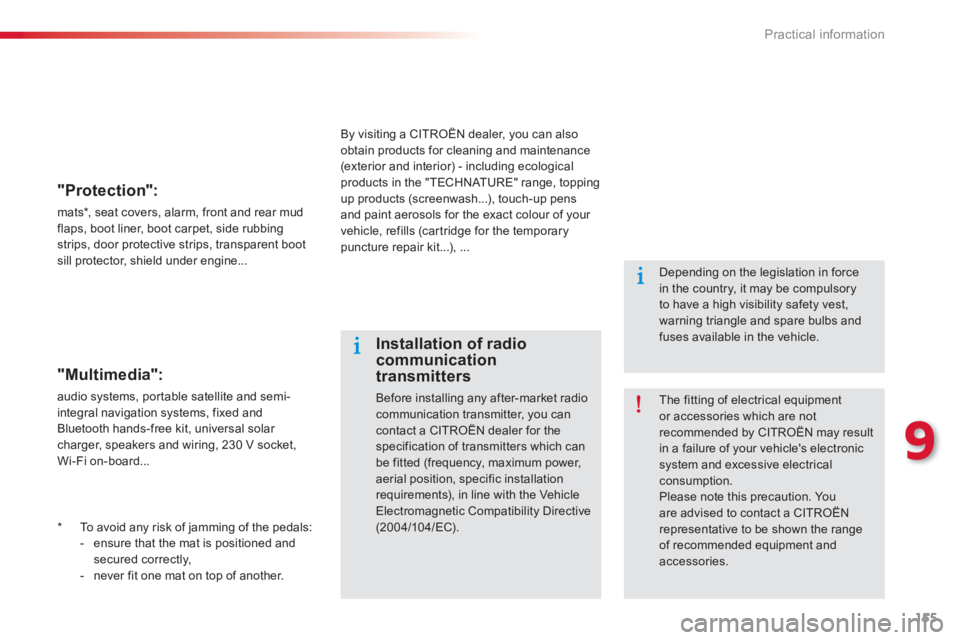
155
9
Practical information
*
To avoid any risk of jamming of the pedals:
- ensure that the mat is positioned and
secured correctly,
- never fit one mat on top of another.
"Protection":
mats *
, seat covers, alarm, front and rear mudflaps, boot liner, boot carpet, side rubbing strips, door protective strips, transparent boot sill protector, shield under engine...
The fitting of electrical equipment or accessories which are not recommended by CITROËN may resultin a failure of your vehicle's electronicsystem and excessive electrical consumption.
Please note this precaution. Youare advised to contact a CITROËNrepresentative to be shown the range of recommended equipment and accessories.
Installation of radiocommunicationtransmitters
Before installing any after-market radiocommunication transmitter, you can
contact a CITROËN dealer for thespecification of transmitters which can be fitted (frequency, maximum power,aerial position, specific installation requirements), in line with the Vehicle Electromagnetic Compatibility Directive (2004/10 4/EC).
Depending on the legislation in forcein the country, it may be compulsory to have a high visibility safety vest,warning triangle and spare bulbs andfuses available in the vehicle. B
y visiting a CITROËN dealer, you can also
obtain products for cleaning and maintenance (exterior and interior) - including ecological products in the "TECHNATURE" range, toppingup products (screenwash...), touch-up pens and paint aerosols for the exact colour of your
vehicle, refills (cartridge for the temporary puncture repair kit...), ...
"Multimedia":
audio systems, portable satellite and semi-
integral navigation systems, fixed and
Bluetooth hands-free kit, universal solar charger, speakers and wiring, 230 V socket,
Wi-Fi on-board...
Page 168 of 257
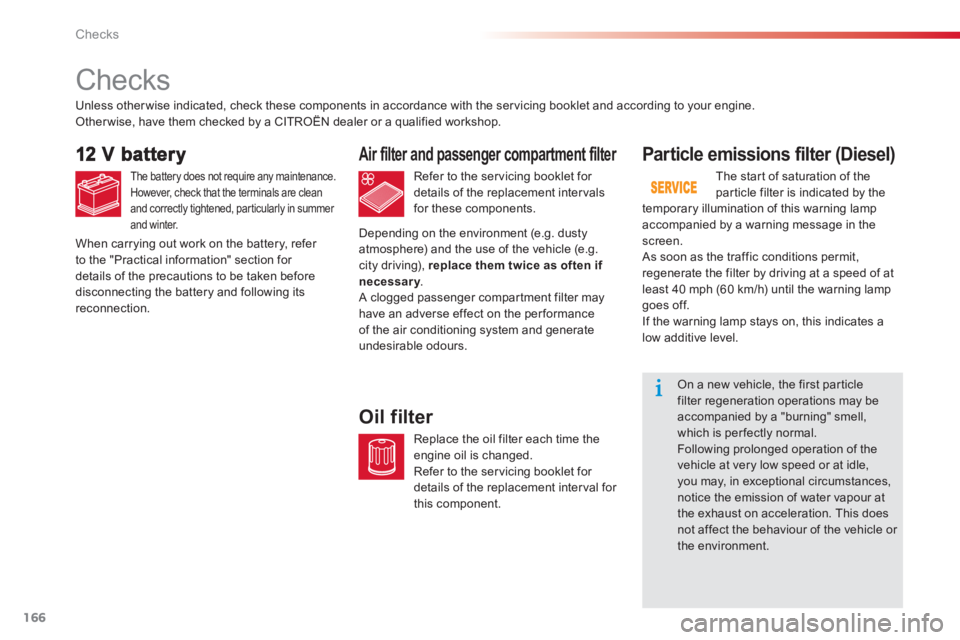
166
Checks
Checks
The battery does not require any maintenance.
However, check that the terminals are clean
and correctl
y tightened, particularly in summer and winter.
Par ticle emissions filter (Diesel)
The start of saturation of thepar ticle filter is indicated by the
temporary illumination of this warning lamp
accompanied by a warning message in the screen.
As soon as the traffic conditions permit,
regenerate the filter by driving at a speed of at
least 40 mph (60 km/h) until the warning lampgoes off.
If the warning lamp stays on, this indicates a
low additive level.
On a new vehicle, the first particlefilter regeneration operations may be accompanied by a "burning" smell,
which is perfectly normal.
Following prolonged operation of the vehicle at very low speed or at idle, you may, in exceptional circumstances,notice the emission of water vapour at the exhaust on acceleration. This does not affect the behaviour of the vehicle or the environment. Unless other wise indicated, check these components in accordance with the ser vicin
g booklet and according to your engine.
Other wise, have them checked by a CITROËN dealer or a qualified workshop.
Air filter and passenger compartment filter
Refer to the servicing booklet for
details of the replacement inter vals
for these components.
Oil filter
Replace the oil filter each time theengine oil is changed.
Refer to the ser vicing booklet for
details of the replacement inter val for
this component. When carr
ying out work on the battery, refer
to the "Practical information" section for
details of the precautions to be taken before
disconnecting the battery and following itsreconnection. Dependin
g on the environment (e.g. dusty
atmosphere) and the use of the vehicle (e.g.city driving), replace them twice as often if necessary.y A clogged passenger compar tment filter may
have an adverse effect on the performance
of the air conditioning system and generateundesirable odours.
Page 169 of 257

167
10
Checks
Manual gearbox
The gearbox does not require anymaintenance (no oil change).
Refer to the servicing booklet for the
details of the level checking interval for this component.
Electronic gearbox
The gearbox does not require any
maintenance (no oil change).
Refer to the ser vicing booklet for
details of the checking interval for
this component.
Automatic gearbox
The gearbox does not require anymaintenance (no oil change).
Refer to the ser vicing booklet for
details of the level checkin
g interval
for this component. Brake wear depends on the st
yleof driving, par ticularly in the caseof vehicles used in town, over shor t
distances. It may be necessary to have
the condition of the brakes checked,even between vehicle services.
Brake pads
For information on checking brake
disc wear, contact a CITROËN dealer
or a qualified workshop.
Brake disc wear
Parking brake
If excessive travel or a loss of
effectiveness of this system isnoticed, the parking brake must be checked, even between two ser vices.
Only use products recommended by CITROËN or products of equivalent quality and specification. In order to optimise the operationof units as impor tant as the braking system, CITROËN selects and offers very specific products.
Checking this system must be done by aCITROËN dealer or a qualified workshop. Unless there is a leak in the circuit, a drop in
the brake fluid level indicates that the brake pads are worn.
Page 228 of 257
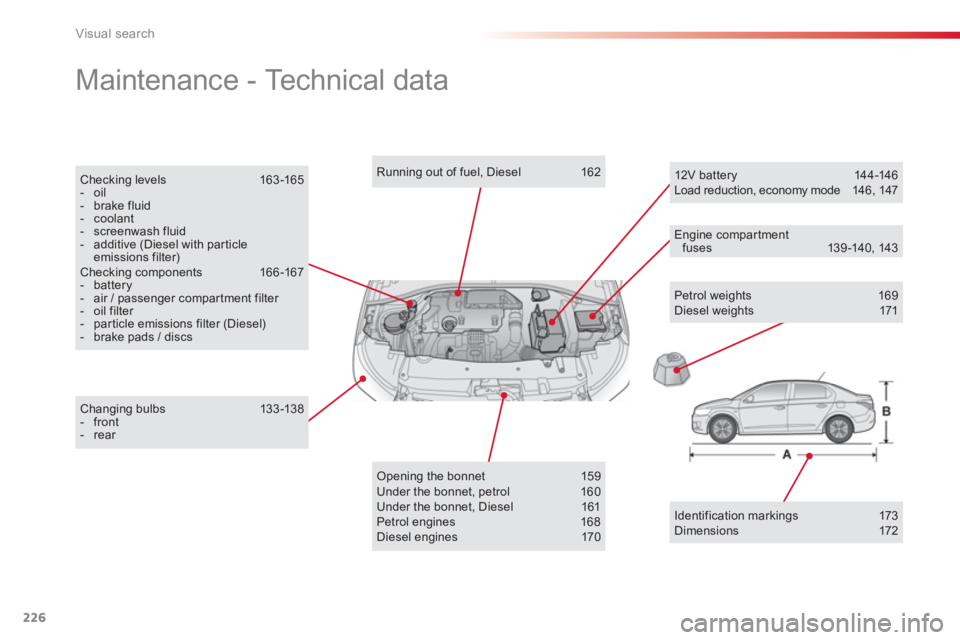
226
Visual search
Maintenance - Technical data
Petrol weights 169 Diesel weights 171
Changing bulbs 133 -138 - front- rear
Running out of fuel, Diesel 162
Opening the bonnet 159 Under the bonnet, petrol 160 Under the bonnet, Diesel 161 Petrol engines 168 Diesel engines 170
12V bat tery 14 4 -146 Load reduction, economy mode 146, 147
Engine compar tment fuses 13 9 -140, 143
Checking levels 163 -165 - oil- brake fluid- coolant- screenwash fluid - additive (Diesel with particleemissions filter)
Checking components 166 -167 - battery - air / passenger compar tment filter - oil filter - particle emissions filter (Diesel)- brake pads / discs
Identification markings 173 Dimensions 172
Page 229 of 257
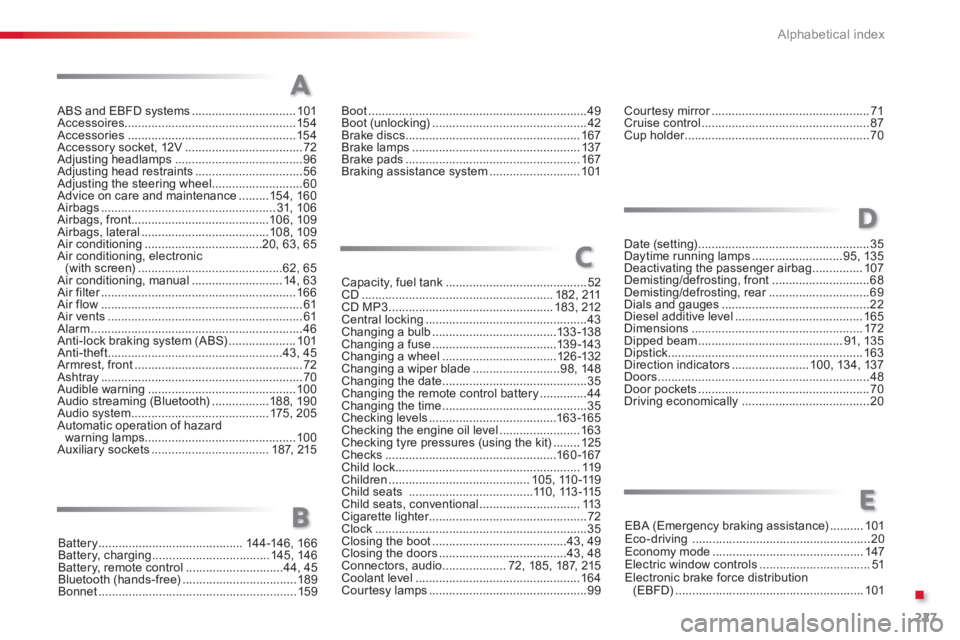
.
227
Alphabetical index
ABS and EBFD systems ...............................101Accessoires...................................................154Accessories..................................................154Accessory socket, 12V ...................................72Adjusting headlamps......................................96Adjusting head restraints................................56Adjusting the steering wheel ...........................60Advice on care and maintenance.........154,160Airbags....................................................31, 106Airbags, front.........................................106, 109Airbags, lateral......................................108, 109Air conditioning...................................20, 63, 65Air conditioning, electronic (with screen)...........................................62,65Air conditioning, manual...........................14, 63Air filter..........................................................r166Air flow............................................................61Air vents..........................................................61Alarm ...............................................................46Anti-lock braking system (ABS)....................101Anti-theft....................................................43, 45Armrest, front..................................................72Ashtray............................................................70Audible warning............................................100Audio streaming (Bluetooth).................188, 190Audio system.........................................175, 205Automatic operation of hazard
warning lamps.............................................100Auxiliary sockets...................................187,215
Boot .................................................................49Boot (unlocking)..............................................42Brake discs....................................................167Brake lamps ..................................................137Brake pads....................................................167Braking assistance system...........................101
Capacity, fuel tank ..........................................52CD.........................................................182, 211CD MP3 .................................................183, 212Central locking................................................43Changing a bulb .....................................133-138Changing a fuse.....................................139-143Changing a wheel..................................126-132Changing a wiper blade..........................98,148Changing the date...........................................35Changing the remote control battery..............44Changing the time...........................................35Checking levels ......................................163-165Checking the engine oil level........................163Checking tyre pressures (using the kit) ........125Checks...................................................160-167Child lock.......................................................119Children ..........................................105, 11 0-11 9Child seats .....................................110, 113-115Child seats, conventional ..............................113Cigarette lighter...............................................r72Clock ...............................................................35Closing the boot........................................43, 49Closing the doors ......................................43, 48Connectors, audio ...................72,185, 187,215Coolant level.................................................164Courtesy lamps...............................................99
A
C
Courtesy mirror...............................................r71Cruise control..................................................87Cup holder.......................................................r70
D
Date (setting)...................................................35Daytime running lamps...........................95,135Deactivating the passenger airbag...............107Demisting/defrosting, front .............................68Demisting/defrosting, rear..............................r69Dials and gauges............................................22Diesel additive level......................................165Dimensions ...................................................172Dipped beam...........................................91,135Dipstick ..........................................................163Direction indicators.......................100, 134, 137Doors...............................................................48Door pockets ...................................................70Driving economically ......................................20
Battery...........................................14 4-146,166Battery, charging...................................145,146Battery, remote control.............................44, 45Bluetooth (hands-free).................................. 189Bonnet ...........................................................159
BEBA (Emergency braking assistance) ..........101Eco-driving .....................................................20Economy mode.............................................147Electric window controls.................................51Electronic brake force distribution(EBFD)........................................................101
E